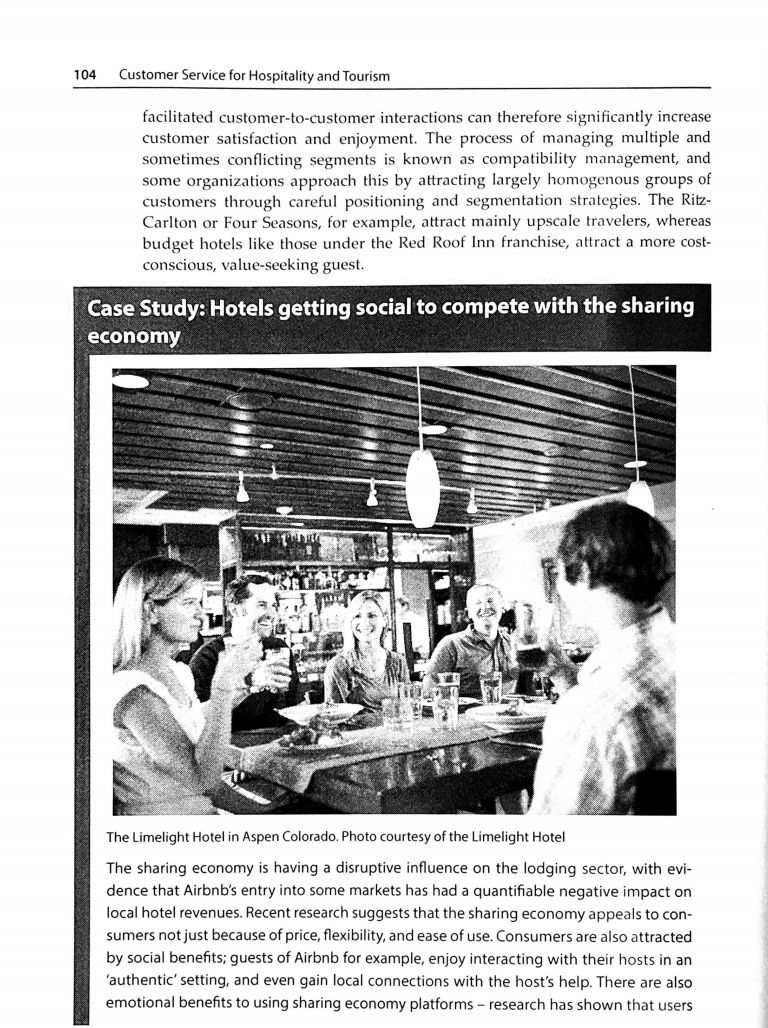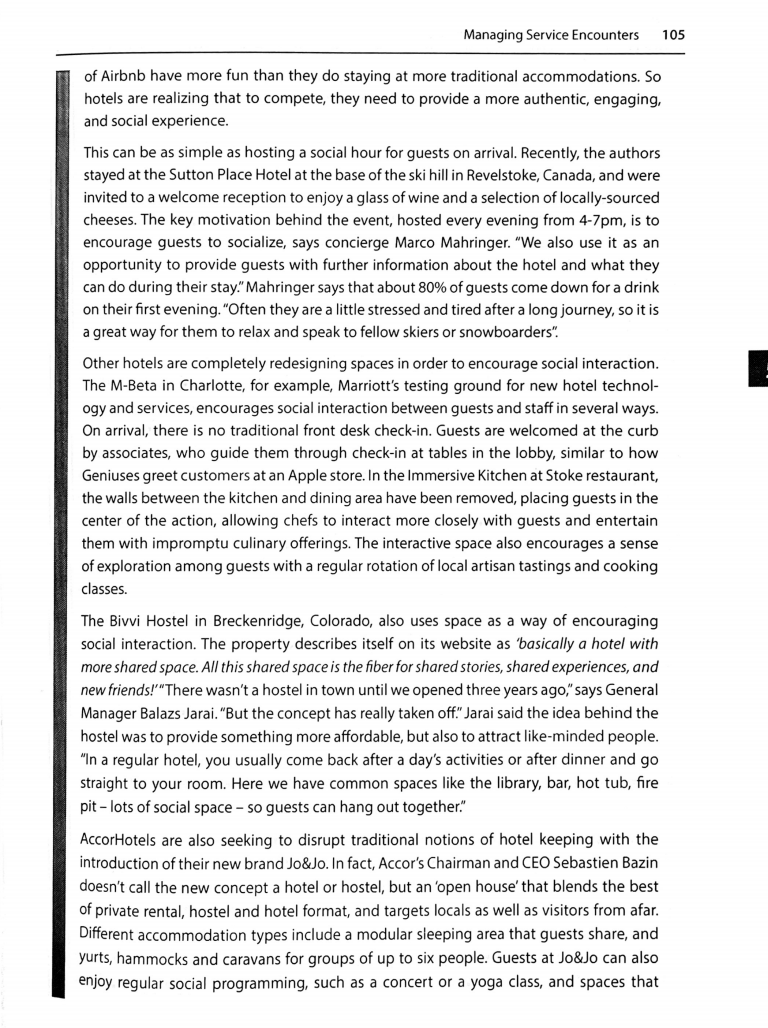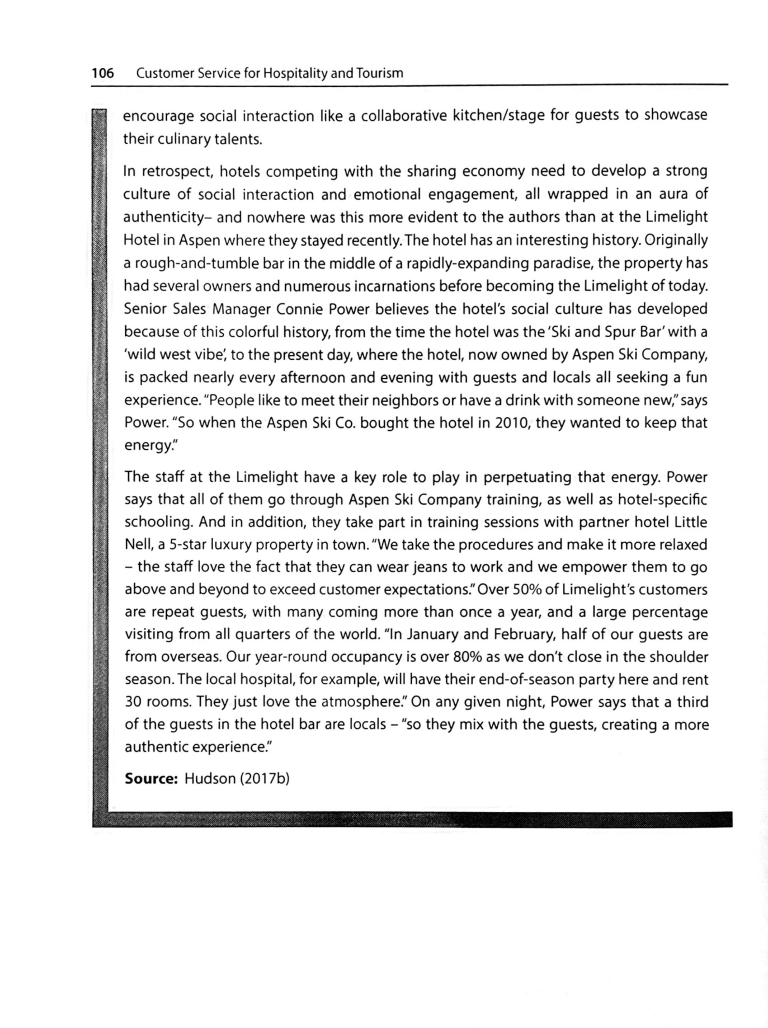Chapter 5 Hotels getting social to compete with the sharing economy (p. 104)
Here are my questions for all case studies:
1. What were the issues?
2. How could these issues have been avoided?
104 Customer Service for Hospitality and Tourism facilitated customer-to-customer interactions can therefore significantly increase customer satisfaction and enjoyment. The process of managing multiple and sometimes conflicting segments is known as compatibility management, and some organizations approach this by attracting largely homogenous groups of customers through careful positioning and segmentation strategies. The Ritz- Carlton or Four Seasons, for example, attract mainly upscale travelers, whereas budget hotels like those under the Red Roof Inn franchise, attract a more cost- conscious, value-seeking guest. Case Study: Hotels getting social to compete with the sharing economy The Limelight Hotel in Aspen Colorado. Photo courtesy of the Limelight Hotel The sharing economy is having a disruptive influence on the lodging sector, with evi- dence that Airbnb's entry into some markets has had a quantifiable negative impact on local hotel revenues. Recent research suggests that the sharing economy appeals to con- sumers not just because of price, flexibility, and ease of use. Consumers are also attracted by social benefits; guests of Airbnb for example, enjoy interacting with their hosts in an 'authentic' setting, and even gain local connections with the host's help. There are also emotional benefits to using sharing economy platforms - research has shown that usersManaging Service Encounters 105 of Airbnb have more fun than they do staying at more traditional accommodations, So hotels are realizing that to compete. they need to provide a more authentic. engaging, and social experience. This can be as simple as hosting a social hour for guests on arrival. Recently. the authors stayed at the Sutton Place Hotel at the base of the ski hill in Fievelstoke. Canada. and were invited to a welcome reception to enjoy a glass ofwine and a selection of locallysourced cheeses. The key motivation behind the event, hosted every evening from 4-?pm. is to encourage guests to socialize, says concierge Marco Mahringer. \"We also use it as an opportunity to provide guests with further information about the hotel and what they can do during their stay."Mahringer says that about 80% of guests come down for a drink on their rst evening. "Often they are a little stressed and tired aftera long journey. so it is a great way for them to relax and speak to fellow skiers or snowboarders\". Other hotels are completely redesigning spaces in order to encourage social interaction. The M-Beta in Charlotte, for example. Marriott's testing ground for new hotel technol ogy and services, encourages social interaction between guests and staff in several ways. On arrival, there is no traditional front desk check-in. Guests are welcomed at the curb by associates. who guide them through check-in at tables in the lobby. similar to how Geniuses g reet customers at an Appl e store. In the lmmersive Kitchen at Stoke restaurant, the walls between the kitchen and dining area have been removed. placing guests in the center of the action. allowing chefs to interact more closely with guests and entertain them with impromptu culinary offerings The interactive space also encourages a sense of exploration among guests with a regular rotation of local artisan tastings and cooking classes. The Bivvi Hostel in Breckenridge, Coiorado. also uses space as a way of encouraging social interaction. The property describes itself on its website as basically a hotel with more shared space. All this shared space is the ber for shared stories. shared experiences. and newfriendsi'\"There wasn't a hostel in town until we opened three years ago."says General Manager Balazs Ja ra i. \"But the concept has really taken of'Jarai said the idea behind the hostel was to provide something more affordable. but also to attract like-minded people. "In a regular hotel, you usually come back after a day's activities or after dinner and go straight to your room. Here we have common spaces like the library. bar, hot tub, re pit lots of social space - so guests can hang out together.\" AccorHotels are also seeking to disrupt traditional notions of hotel keeping with the introduction of their new brand JoStJo. In fact, Accor's Chairman and CEO Sebastien Bazin doesn't call the new concept a hotel or hostel. but an 'open house\" that blends the best of private rental. hostel and hotel format. and targets locals as well as visitors from afar. Different accommodation types include a modular sleeping area that guests share. and runs, hammocks and caravans for groups of up to six people. Guests at Jo&Jo can also enjoy regular social programming, such as a concert or a yoga class. and spaces that 106 Customer Service for Hospitality and Tourism encourage social interaction like a collaborative kitchenfstage for guests to showcase their culinary talents. In retrospect. hotels competing with the sharing economy need to develop a strong culture of social interaction and emotional engagement. all wrapped in an aura of authenticity- and nowhere was this more evident to the authors than at the Limelight Hotel in Aspen where they stayed recently. The hotel has an interesting history. Originally a roughand-tumble bar in the middle ofa rapidly-expanding paradise. the property has had several owners and numerous incarnations before becoming the Limelight of today. Senior Sales Manager Connie Power believes the hotel's social culture has developed because of this colorful history, from the time the hotel was the 'Ski and Spur Bar' with a 'wild west vibe'. to the present day, where the hotel, now owned by Aspen Ski Company. is packed nearly every afternoon and evening with guests and locals all seeking a fun experience. "Peo ple like to meet their neighbors or have a drink with someone neW.\" says Power. \"50 when the Aspen Ski Co. bought the hotel in 2010, they wanted to keep that energy.\" The staff at the Limelight have a key role to play in perpetuating that energy. Power says that all of them go through Aspen Ski Company training. as well as hotel-specic schooling. And in addition. they take part in training sessions with partner hotel Little Nell. a 5-star luxury property in town."We take the procedures and make it more relaxed - the staff love the fact that they can wear jeans to work and we empower them to go above and beyond to exceed customer expectation 5." Over 50% of Limelight's customers are repeat guests. with many coming more than once a yearI and a large percentage visiting from all quarters of the world. \"in January and February, half of our guests are from overseas Our year-round occupancy is over 80% as we don't close in the shoulder season. The local hospital. for example. will have their end-ofseason party here and rent 30 rooms. They just love the atmosphere!\" On any given night. Power says that a third of the guests in the hatel bar are locals - "so they mix with the guests, creating a more authentic experience." Source: Hudson {201er









